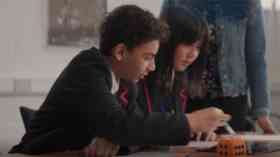
Designed and made in Britain: education’s role
With a government focus on traditional subjects via the Ebacc, technical subjects are left fighting for educational survival, argues Richard Green of the Design and Technology Association.
The Design and Technology Association, the UK’s only professional association for all those involved in Design & Technology (D&T) education, recently launched its ‘Designed and Made in Britain..?’ campaign. The campaign is designed to draw urgent attention to the crisis facing our school system, where the drive for league table success and OFSTED approval is pushing D&T and the other creative subjects into an academic backwater.
A panel of speakers at the launch event delivered a series of impassioned and insightful speeches. Among the speakers was Dr Rhys Morgan, – Director of Engineering Education, Royal Academy of Engineering. He commented: “D&T is a key subject in drawing the next generation towards engineering. It makes a critical link between science and mathematics and provides the real world contexts in which these subjects are applied through design.
“With the UK facing critical shortages of engineers over the next five years, it is imperative that we do all we can to provide as many learning opportunities for students to develop skills in design and engineering and also to see the immense variety of exciting, creative opportunities that design, engineering and technology careers can bring. However, D&T is not just about future engineers. It is the only subject in the curriculum where young people can learn about the world they live in – not the natural world – but the ‘made’ world, with which they interact far more frequently.
“By teaching D&T, we are ensuring that all children are not just passive bystanders in our increasingly technology-driven world, but are informed citizens who understand how design impacts on their quality of life and how technology can be used for the benefit of mankind.”
Misunderstood
Since 2004, the UK has seen the number of students taking a GCSE in D&T drop by more than a half, yet at the same time politicians are demanding more great British design to bolster British manufacturing and, in turn, balance the economy. D&T is a widely misunderstood and misrepresented subject. For too many people - including ministers, employers and parents - it is still perceived as the subject they probably studied when they were at school, i.e. woodwork or metalwork.
The reality of D&T is hugely different. It is the subject which can put the T (technology) and E (engineering) into STEM and does so within curriculum time, not as part of extra-curricular, enhancement and enrichment activities. It is the subject that can help inspire and attract the next generation of engineers and technicians. It is the subject that helps young people develop a feel for materials and how they can be worked and finished.
D&T develops and exercises pupils’ ability to be creative and imaginative and so enables them to apply these skills when facing the wide variety of real challenges they will likely encounter in their working lives and leisure time. However, we have a problem or, rather, we have a series of problems. First, the subject is often invisible. Ministers never refer to it when talking about STEM. When they do talk about ‘technology’ they are usually thinking of computing.
Second, uncertainty about the future of the subject during the recent national curriculum review has discouraged potential secondary D&T teachers from applying for Initial Teacher Training (ITT) courses. Come next September, there will be at least 2,000 fewer teachers in the system than are needed – a vacancy in two in three secondary schools.
Government bursaries are available to those considering training to teach shortage subjects and should help to address this shortfall. D&T is experiencing the greatest shortage of all subjects but those wanting to teach it can only get a maximum busary of £12,500, compared to £30,000 for those wanting to teach maths, physics or computing. Not a realistic incentive to enter the D&T teaching profession.
Finally, government policies and accountability measures work against a broad and balanced curriculum to meet all pupils’ needs and interests. For example, 61 per cent of secondary schools and 15 per cent of primary schools are now academies or free schools and so do not have to teach the national curriculum. Thus their pupils’ entitlement to D&T education is not guaranteed.
Primary schools are judged on pupils’ performance in English and maths, which consequently takes up over 50 per cent of teaching time, compared with five per cent or less for D&T. Secondary schools are judged on pupils’ GCSE grades in English Baccalaureate (EBacc) subjects (English, mathematics, history or geography, science and a language). There is no incentive for pupils to study D&T.
Until 2004, D&T was a compulsory GCSE subject, but the loss of statutory status and current accountability measures have resulted in a 50 per cent fall in D&T GCSE entries between 2003 and 2014. This has been further compounded by the recent proposal that no school will be considered as ‘Outstanding’ by Ofsted from September 2015 unless 90 per cent of pupils study EBacc GCSEs – a further disincentive to study D&T. Consequently D&T is increasingly marginalised in many schools and, in a few, is cut from the curriculum completely.
A storm of problems
The irony is that this is happening as China, South Korea and other South East Asian countries are visiting the UK to learn how D&T is taught in schools here. They recognise that their curricula lack the design and creative problem solving, linked to technical knowledge and practical making skills, which D&T provides.
How do we counter this perfect storm of problems? The Design and Technology Association believes that the government must: change its accountability measures to include a creative/technical subject for all pupils at Key Stage 4; address D&T teacher shortages by equalising bursary incentives to attract the best entrants into ITT; promote wider understanding of D&T, its contribution to STEM and to career paths in engineering and the creative industries.
The examination bodies also have a part to play. At the time of writing they are developing new D&T GCSE and A level qualifications. These new qualifications must be rigorous and challenging if they are to increase the credibility of the subject. However, these will not be taught for the first time until September 2017 and, for all the reasons outlined above, D&T in some schools could continue to decline over this period unless the government acts now.
The D&T community also has a part to play by: ensuring the subject is modern, relevant and fit for the 21st century; providing CPD that improves and extends teachers’ subject knowledge; and taking every opportunity to publicise D&T and related careers to parents, school management (including governors) and employers.
Much work is taking place in schools to raise standards. However, the government’s focus on traditional academic subjects, via the Ebacc accountability measure, means that creative and technical subjects are fighting for curriculum survival. In a recent survey conducted by the Design and Technology Association, 705 of 1,300 respondents said that government accountability measures were resulting in decreasing numbers of pupils opting to study the subject at GCSE.
Following on from the point about publicising D&T and related careers, employers can play a significant role too by: collaborating in developing real-life and relevant D&T activities and resources; helping D&T teachers engage with professional practice through work experience, internships and apprenticeships; and helping to highlight D&T’s value to government departments through their companies and professional institution.
Action and thought
It is worth pointing out that elite industry names from the ‘Best of British’, including Dyson, JCB, Williams F1, Brompton and a host of other household names, are supporting the Design and Technology Association’s ‘Designed and Made in Britain..?’ campaign. All are at the pinnacle of their respective industries and are crying out for the next generation of school leavers who will be capable of problem-solving and delivering innovative skills. The fact is that effectively taught D&T can meet this need and beyond.
D&T is often, mistakenly, regarded as just a practical subject. The reality is that it’s a complex mix of action and thought. Studying D&T develops the creative, technical and practical understanding and expertise needed to perform everyday tasks at home and in the work place with confidence. Young people engaged in designing and making activities are challenged to think innovatively and to create products, services and systems which may enhance, improve and secure the quality of their own lives, those of others, and thereby contribute to the creativity, culture, wealth and well-being of the nation. The ability to analyse, interpret and respond to the needs of users is a cerebral, rigorous and challenging skill when undertaken thoroughly.
I have heard it said that we are very good at teaching young people about the natural world. However, it is the designed and made world with which they will interact far more frequently and we ignore this aspect of their education at our peril.
Learning by doing
D&T allows pupils to understand and participate successfully in an increasingly technological world, so that they may critique and make informed judgements about the appropriate use of existing, new and emerging technology in the immediate and wider world in which they live.
‘Learning by doing’ is a very effective learning strategy for many young people. Developing practical skills and knowledge of tools and materials, and having the confidence to employ them are skills which, some would argue, are disappearing from the younger generation. Design thinking is also an essential business strategy which is applicable in, for example, medicine, finance and the law just as much as in design, manufacturing and engineering careers.
Unless we can achieve the changes described, too many pupils will lose out on a design and technological education which is essential for life in an advanced technological society. Too many will miss out on the opportunity to have their interest in design, manufacturing and engineering careers awoken through practical designing and making activities. How often have we heard the phrase ‘unintended consequences’? The respect and priority accorded to D&T must be reconsidered in light of the needs and expectations of pupils, students and Britain’s reputation for design and innovation and its contribution to the GB plc economy. Failure to do this risks throwing the innovation baby out with the education bathwater.
Further Information
www.data.org.uk
Latest News
08/01/2026 - 10:30
The government is launching a new app allowing students to view their GCSE results on their phones for the first time from this summer.
08/01/2026 - 09:45
Education Business LIVE has announced that Professor Samantha Twiselton OBE of Sheffield Hallam University will speak at the event in March 2026, delivering two thought-provoking sessions focused on initial teacher training and SEND provision.
07/01/2026 - 10:10
Solve for Tomorrow is a free, curriculum-linked programme which is mapped to Gatsby Benchmarks 4, 5, and 6, helping teachers embed careers education without adding to workload.
06/01/2026 - 10:24
London's universal free school meals programme has not led to improvements in pupil attainment during its first year, but has eased financial pressure and reduced stress for families.
05/01/2026 - 10:44
New regulations have come into force from today, banning adverts for unhealthy food and drinks before 9pm, and online at all times.







